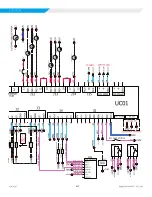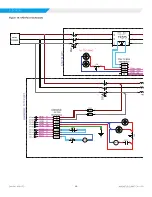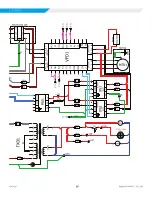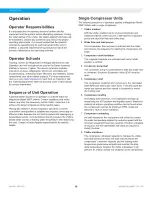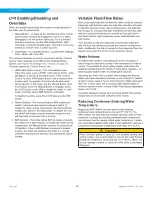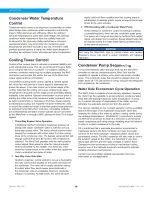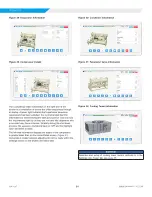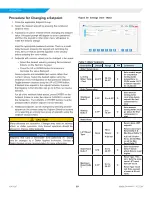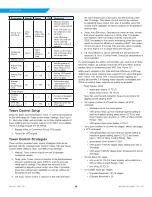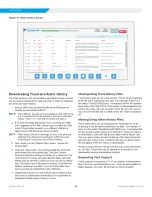
27
IOM 1297
WWW.DAIKINAPPLIED.COM
OPERATION
Unit Enabling/Disabling and
Overrides
There are multiple options that will override normal operation of
the chiller and its compressors:
1 .
Manual Button - Located on the outside front of the control
panel. Button needs to be engaged for unit to run. When
disengaged, unit will perform rapid stop. For a controlled
shutdown sequence, use the HMI Enable Button, BAS
command, or Remote Enable signal. This button is the only
method to override other “Control Sources”.
2 .
Compressor 1 or 2 Enable Setting - Located in the Settings
menu, Modes tab in the HMI.
The overrides listed above work in conjunction with the “Control
Source” that is selected in the HMI via the Settings/Modes
Screen, see
“Figure 36: Settings View - Modes” on page 34
The three options for “Control Source” are:
1 .
HMI Enable Button (Local) - This is the default mode.
When this mode is set, a STOP button and an AUTO button
will appear at the top of the HMI screens. If the “Control
Source” is set to “HMI Enable Button” and a remote switch
is being used, the position of the Remote Enable switch
will be ignored. In that case, only the Manual Button need
to be closed. Once the Manual Button is engaged, press
the AUTO button on the HMI to enable the chiller in “User”
mode. It will also ignore BAS Network commands.
To disable the chiller, press the STOP button on the HMI
screen.
2 .
Remote Enable - This mode will ignore BAS enable and
disable commands and requires a physical switch. To
enable the chiller and its compressors, the Manual Button
needs to be closed in the ON position. To disable the unit,
this switch will initiate a normal controlled sequence and
will stop each compressor that is running.
3 .
BAS Network - This mode allows BAS to enable or disable
the chiller over a BAS network. To enable the chiller and its
compressors, the Manual Button needs to be closed in the
ON position. When a BAS Network command to disable
is given, the chiller will shutdown the chiller in a normal
controlled sequence and will stop each compressor that is
running.
Variable Fluid Flow Rates
Both excessively high and low fluid flow rates should be avoided.
Extremely high fluid flow rates and high tube velocities will result
in high fluid pressure drops, high pumping power, and potential
tube erosion or corrosion damage. Extremely low fluid flow rates
and low velocities should also be avoided as they will result in
poor heat transfer, high compressor power, sedimentation and
tube fouling.
If it is decided to vary the evaporator or condenser water flow
rate, the flow rate should not exceed the minimum or maximum
limits. Additionally, the rate of change for the evaporator flow rate
should not exceed 10% of the current value per minute.
Water Volume
All chilled water systems need adequate time to recognize a
load change to avoid short cycling of the compressors or loss of
control. The potential for short cycling usually exists when the
building load falls below the minimum chiller plant capacity or on
close-coupled systems with very small water volumes.
Assuming that there are no sudden load changes and that the
chiller plant has reasonable turndown, a rule of thumb of “gallons
of water volume equal to two to three times the chilled water gpm
flow rate” is often used. For a more accurate determination of
minimum system volume, consult Chiller Plant Design Application
Guide, AG 31-003.
A properly designed storage tank should be added if the system
components do not provide sufficient water volume.
Reducing Condenser Entering Water
Temperature
Magnitude WMT chillers can start and run with entering
condenser water temperatures as low as 40°F (4.4°C). The
WMT chillers can also start and maintain operation with inverted
conditions, meaning the entering condenser water temperature
can be lower than the leaving chilled water temperature. Contact
your local Daikin Applied sales office if your application requires a
condenser entering water temperature lower than 40°F (4.4°C).
CAUTION
When common piping is used for both building heating and
cooling modes, care must be taken to provide that water flowing
through the evaporator cannot exceed 115°F (46°C). Water this
hot can damage controls or cause the relief valve to discharge
refrigerant.





